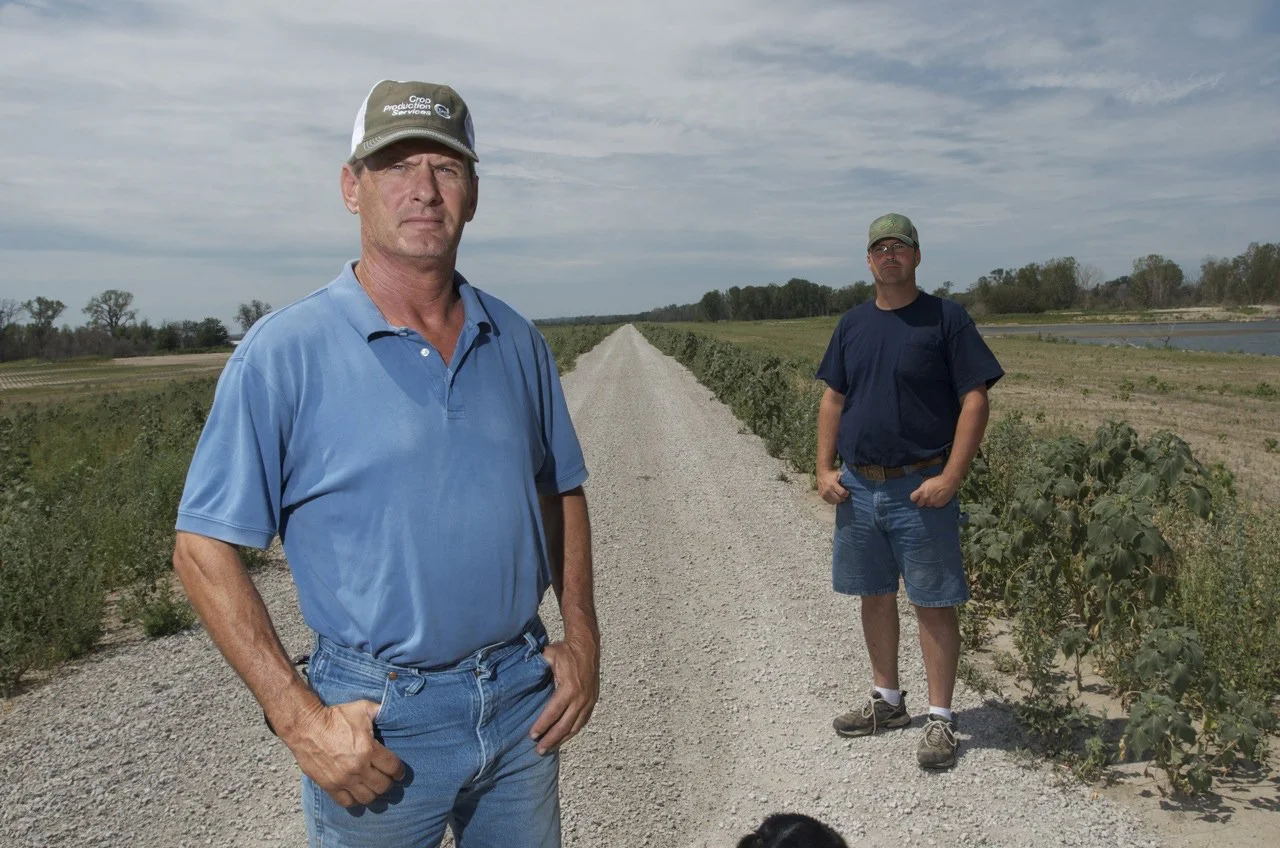Missouri River flood recovery

By Joseph L. Murphy
Today driving through the I-29 corridor near Iowa towns like Hamburg and Percival you would never know the area had experienced a widespread flood. Crops are green, businesses are open, and people are getting back to their normal lives. That was not the case one year ago when the over swollen Missouri River breached levees in Fremont County sending water on a destructive course killing crops, destroying roads and ruining homes from Sioux City to Hamburg.
Leo Ettleman and Jeff Jorgenson stand on a recently rebuilt levee near the Missouri River. The U.S. Army Corps of Engineers repaired the levees back to the original flood protection giving residents the security to rebuild their farms and homes. (Photo: Joseph L. Murphy)
People in Iowa, Nebraska and Missouri, had to deal with the prolonged flooding and damage. Farmers like Jeff Jorgenson, an Iowa Soybean Association Director, and Leo Ettleman, an Iowa Soybean Association member, witnessed significant losses and damage to their cropland, homes and roads. Some areas dealt with floodwaters from June to November of last year.
“Overall we are very pleased with the progress.” Ettleman said looking at one of his soybean fields. “The goal was to get our security back, through flood risk reduction, to where we could get on with our lives, get our homes back, get the roads back and get commerce back.”
To accomplish that, they needed help from the federal government to rebuild levees that were breached during the flood. Ettleman along with other farmers in the area formed the group Responsible River Management (RRM) That group has been credited with creating a unified voice for agricultural interests in the area while making flood control needs known to the Army Corps of Engineers.
“Some of the projects in the past have been detrimental to agriculture and to flood risk,” Ettleman said. “Now they are (U.S. Army Corps of Engineers) starting to see, by us being at the table, that those things need to change.”
The main focus of the group following the flood last year was to regain flood control at the original 100-year protection levels. Due to a lack of funding the U.S. Army Corps of Engineers originally planned to repair the levees at 25-year flood levels. By doing that crop insurance would be jeopardized for many farms in the area. After a flood of calls from farmers and others involved with RRM, the federal government recognized the importance of rebuilding the levees to the original strength.
“Now, I think they see that when flood control fails everything fails,” Ettleman said about the U.S. Army Corps of Engineers. “Fish and wildlife projects were shot, recreation was shot, and everything fails when flood control fails.”
In late December, the U.S. Army Corps of Engineers received the funding that they needed to restore the levees to the original strength. That, combined with a mild winter, allowed the construction projects to go full speed ahead. By the beginning of March, the levees repairs were completed.
“The protection that they are helping to provide (RRM) for Fremont County is tremendous,” Jorgenson said. “Otherwise you feel like you are getting stepped on. The RRM understands policy better than most of the people at the state house when it comes to the U.S. Army Corps of Engineers and the Department of the Interior.”
Once the protection of their farms and fields were secure both Jorgenson and Ettleman said they were able to focus on recovering from the floodwaters and preparing their fields for spring planting. “The outlook in October was very meager because we didn’t know if we could get back in and start farming again,” Jorgenson said. “For the most part we were able to plant like normal this spring. The weather bailed us out. Otherwise, it would have been a whole different situation.”
The mild winter weather allowed farmers in the area to fill holes and move sand off of many fields in the area. Jorgensen said that he moved 4,000 yards of sand a day for twelve days to get just one 80 acre section cleaned up. Today the crop stands look healthy in the impacted fields, and both Ettleman and Jorgenson are optimistic for average yielding beans. Although they are concerned that continued dry weather could impact the crops quickly because of the sandy soil. “We’ve got good stands, and we’ve had some timely rains,” Ettleman said. “ We’re very pleased with the progress.”
Neither farmer would have expected to be in this good of a situation after the destruction they experienced last year. Now they have optimism that newly constructed levees can offer the protection needed for them to concentrate on their farms. Ettleman hopes that, in the next five years, his farm and life will be back to normal.
“There’s about two years of progress done now, and it happened in the last six months,” Jorgensen said. “But now it will slow down because we will be fine tuning the soil to get the production back to where we want it. That will take time.” For more information on Responsible River Management you can follow this link: http://responsiblerivermanagement.com/
For more than two decades, Joseph L. Murphy has had the pleasure of meeting and connecting with people from all walks of life through photography. He has photographed presidents and heads of state, traversed the winding alleyways of the Fes Medina in Morocco, photographed the sprawling countryside and people that make up Argentina and covered events that have defined the U.S. Most recently, Murphy’s travels have taken him to Cambodia, Mexico, China, Vietnam and Ecuador.
He has spent the past 20 years specializing in agriculture photography for multiple organizations, publications and marketing projects.
A graduate of the University of Iowa, Murphy determined at an early age that his love of photography would shape his vision for life.


